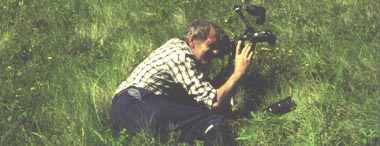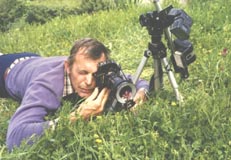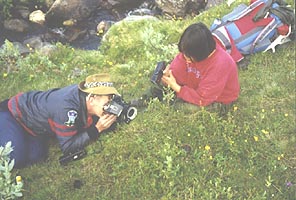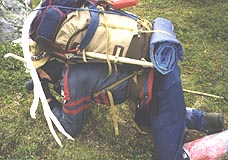Part of the challenge in photographing orchids is to get the maximum effect from the image. Too many photographers photograph Bee orchids "fully face-on" and fail to even scratch the beauty of this fascinating genus with its very important three-dimensional character. These flowers must be seen partially from the side to capture their really amazing variety of features. If one can find two flowers open on a spike, with minimum vertical difference so that they are very close, then shooting the pair together, carefully framing them, makes for a really live study.
While unpacking hundreds of slides and photographs of European wild orchids and bee orchids during a recent move, one of my former students suggested that I choose some selected images from my personal collection and make them available online, together with the story behind the images. So here is the story: I'll start at the very beginning.
Text Continues Below
Images of European Wild Orchids and Bee Orchids
Orchids Whole Plants
Orchis purpurea
Orchis ustulata
Orchis pallens
Orchis anatolica
Orchids Whole Plants
with Closeups of Flower Spikes
Orchis morio
Orchis morio flower
Orchis simia
Orchis simia flower
Orchis militaris
Orchis militaris flower
Orchis longicornu
Orchis longicornu flower
Orchis quadripunctata
Orchis quadripunctata flower
Orchis collina
Orchis collina flower
Orchis pauciflora
Orchis pauciflora flower
Orchis and Epipactis Closeups
Orchis papilionacea
Orchis lactea
Epipactis palustris
Epipactis purpurata
Epipactis atrorubens
Bee Orchids
Ophrys insectifera
Ophrys sphegodes
Ophrys sphegodes
Ophrys sphegodes
Ophrys apifera
Ophrys tenthredinifera
Ophrys reinholdii
Ophrys regis-ferdinandii
Ophrys umbilicata
Ophrys vernixia
Ophrys lutea-lutea
Ophrys argolica
Ophrys argolica
Ophrys apulica
Ophrys crabronifera
Ophrys atrata (incubaceaa)
Ophrys lutea-sicula
Ophrys cretica
Ophrys aesculapii
Ophrys oestrifera-cornuta
Ophrys mammosa
Ophrys ferrum-equinum
Discovering Orchids
![[Click to View]](orchis_morio_bloom_tn.jpg)
I saw my first wild European orchid while at school in Crediton, Devon (southwest England). It was an Early Purple orchid (Orchis mascula) and I was struck by the delicacy and vivid colouration of the flowers and their dense positioning on the flower stem, the flower spike. A short time later, while walking on Dartmoor, I saw a second species of wild orchid, the Spotted Marsh orchid (Dactylorhiza maculata). Upon moving to Somerset, I discovered my third wild orchid, the Green Winged orchid (Orchis morio) in a field directly opposite our rented cottage.
While book-buying for Bristol University's Zoology course in 1958, I committed an heretical act! I found a very interesting volume in Collins' New Naturalist series, 'Wild Orchids of Britain' by Victor Summerhayes. As a zoology student I was supposed to be buying zoology books... but this book was a must; the photographs were much better than the black and white line illustrations in previous reference works. I just had to have it.
![[Click to View]](epipactis_palustris_tn.jpg)
The photos in the Summerhayes book were amazing ... to discover that such strange flowers were to be found in Britain! Two of the colour photos struck me particularly strongly - a shot of the solitary Marsh Helleborine plant (Epipactis palustris) from Wiltshire and the gorgeous, blue marked Early Spider orchid (Ophrys sphegodes) from Dorset. Strangely, in 20 years time I would be eagerly hunting for these plants, expressly to take my own photos!
![[Click to View]](ophrys_sphegodes_2_tn.jpg)
That was the spark that ignited my interest in orchids, which waned for several years until one bright afternoon, at the Nature Reserve close to the Rhone-Arve river at Aire La Ville near Geneva, Switzerland where I had begun teaching at the International School.
One of my colleagues, Reg Unitt had suggested that we take the Advanced Placement Biology class and the very first International Baccalaureate Biology class to the nature reserve for a small session of Field work. As we counted the different species of flowering plants, I stumbled on what was my first ever Monkey orchid! This, according to the Summerhayes text is a very great rarity in Great Britain. I was awe-struck.
![[Click to View]](orchis_militaris_tn.jpg)
While mentioning this to Reg, suddenly, with a triumphant shout, one of our pupils, Gene Feder came striding through the grass holding the entire plant of another great British rarity, the Military or Soldier orchid... Gene was holding the "entire" plant with roots, tubers, leaves, flower stem and the sod from which he had pulled it.
"Look at this, Mr Unitt..." he began ...
Reg had gone white. We were in the nature reserve and, bearing down on us
was one of the wardens...
We somehow escaped, although I can't remember how.
Gene went on to distinguish himself... Later, in October 1970, he very
politely corrected Dr. Alfred Vester of the Max Planck Institute who,
during a series of lectures on 'Modern Biology' at CERN, got himself
in a twist by mixing up the distribution of sex chromosomes in
Mammals, by stating that
" In ze male, zere are 2 of ze X, vile in ze female zere are
von of ze X and von of ze Vy'"
Gene put up his hand and, egged on by John McArdle and Reg Unitt who
were quietly grinning and stirring, said-
"Er, Doctor Vester, sir; Doctor Vester; I think you have it wrong".
Gene should get a gallantry award for that: Dr Vester was indeed wrong.
A year later, at Sussex University Gene also became famous...and was still
remembered when I visited there in October 1987, some 15 years
later. But that is another story.
Text Continues Below
Sponsor Links
Perfecting the Lighting

A few years on, a new teacher joined our school's Biology department. Tony Dilley was another of that now rare kind of biology teacher which our school had made a point of hiring, those with a deep interest in Natural History and the ability to recognise many wild plants and animals. We are a dying breed. Reg? John? are you listening out there?
Tony and I would go "plant 'untin" within driving distance of Geneva, and one May we began a weekend exploration group to which all IB Biologists were automatically invited. Orchids began to emerge as regular finds for our group, especially when we ventured to the Jura mountain's summit and slopes. Most of these species I had never seen before, some not occurring at all in Great Britain and certainly not in the 'New Naturalists' book, the most authoritative reference that I possessed. By the spring and summer of that year, I began to get an itch to try to photograph these flowers in close up.
I went to Singapore a couple years later to join Tony Dilley at the United World College of South East Asia. It was during one of the summer vacations that I found Collins latest 'Field Guide to Wild Orchids of Britain and Europe'. The book was amazing.
Britain has over 50 species of orchids but continental Europe has hundreds, with the Bee Orchids especially stunning in their variety. The drawings and illustrations in the Collins book were not quite as good as photographs, but nevertheless served well. Photographing these specimens to capture their details and features became a personal goal.

By then I was beginning to take many more photographs of orchids to display with a high level of detail, but the results were still a long way off from what I really wanted to achieve. Then, after 6 months teaching at a school in Italy, I read about a system for close up photography which used a 'ring' flash. While the idea may have been intriguing, it seemed to me to be an expensive toy.
I soon returned to Bristol in the west of England. By astounding coincidence, I recontacted a former student who had already made his mark as one of the few who had demonstrated a genuine interest in Natural History; Blair Fraser.
We met by chance while I was in the local branch of 'Prontoprint' collecting the latest batch of enlargements of wild orchid photos that I had made in Italy. I had been selling these to friends and former students and it was actually managing to make a "few bob". Assisting in this small enterprise were former students Nick Konialidis and Emma Mella. As I checked the prints a customer came in, and in a voice that I had not heard for several years enquired after his order. It was Blair!
![[Click to View]](ophrys_apulica_tn.jpg)
By the spring of that year we were visiting Bristol's Avon Gorge, a veritable treasure trove of wild orchids, based as it is, on a limestone soil. Blair was into very slow slide film, ISO 50 while I was still pottering with fast negative film, ISO 400. I saw Blair's results and changed to slide film, still fast. He was forever cursing the wind because the plants moved, producing blurred images.
In the autumn, I began job at Millfield school in Somerset. Here the laboratory technician persuaded me to use the same slow film as Blair but to try using a flash, specifically a 'ring' flash. I found one, 'occasion', for sale in "Amateur Photographer" and began put it to the test! To it I added a more powerful flash to imitate the sun and create a shadow to right or left of the subject.
In May, Blair and I went to the Dorset coast and to Kent's famous reserves, both on very chalky soils. The results of the new lighting system were astounding. Some of these first photos were chosen by Britain's BBC in 2004 to illustrate some of Great Britain's rarest wild orchids.
I then adapted a strange, toy-like gadget that I had bought in Singapore (and never used) and added a 3rd flash to shoot over the top of the subject in order to illuminate the background. And that's it. The new lighting system cost a shoestring and is still with me.
![[Click to View]](ophrys_regis-ferdinandii_tn.jpg)
The lighting gear was last used several years ago, when I was photographing the early stages of the lives of the caterpillars of Hong Kong's Swallowtail Butterflies. For all that idleness, it is now being put to good use just 50 meters from the house that I recently built in Poland, where there is a marsh with a large population of Dactylorhiza Marsh orchids that bloom every May. One day, when I have finally unpacked all of the boxes shipped from Great Britain, I will go and grovel in the mud. That my friends is the only way to get really close studies of the Marsh orchids!
Text Continues Below
About the Author
The late Dick Hutchings was a Biology teacher who taught a very large number of students preparing for the International Baccalaureate and the Advanced Placement examinations. Over the course of more than four decades Dick taught at schools in Europe, Africa, and Asia.
His interest in Natural Science extended beyond orchids to a wide range of plant and animal species. After a long teaching career he retired to some acreage in the countryside of Poland where he built a house from a design discovered in northern Finnland.
A number of images selected from Dick's personal collection of hundreds of slides and photographs were made available for this web site presentation. Prints, postcards, and posters of these images are available by special order.
Along the Way
There are many people who have featured in this long trek to find and photograph these amazing plants and their stunning blooms. Those who have featured prominently in this story, along with Blair Fraser, include Mrs Mary Thatcher, mother of Linda and Shaw, who put me onto some of the best orchid sites within easy reach of Geneva.
![Orchis militaris flower [Click to View]](orchis_militaris_bloom_tn.jpg)
![Epipactis palustris [Click to View]](epipactis_palustris_tn.jpg)
The shots of Orchis pallens, O. militaris and Epipactis palustris are all thanks to her. Sadly the habitat at La Rippe, where we discovered the O. militaris and Epipactis palustris, was wrecked some time between 1977 and 1986 when it "improved" by having its drainage deepened.

Gavin Taylor and his father Colin, of CERN, helped no end by hosting me in May 1986 and, using Colin's Mercedes, Gavin drove me the length and breadth of the lake area as well as in the Jura's extension past Nantua. The trip yielded wonderful results at Matafelon, the Col du Berthiand, the Col du Corbier and on the north facing slopes' of the Jura above Nyon.
Blair Fraser suggested a visit Rhodos after he took a trip there in 1986 and gave me a list of hot tips for orchid sites as well as recommending a side-trip to Kamiros Skala, where, I am told, my small 'Thank you' present is still on display in the bar-dining room. I went to Rhodos in March-April 1988.

Jan Smit, of the AP Biology class of 1971-72, recontacted me in 1982 while I was spending a very eventful year (and losing weight through 'anxiety') in Lesotho, Southern Africa. Jan came to Europe in South Africa's diplomatic Corps in 1984 and during his stint in London in 1986, we did Italy, Sardegna, and Sicilia. During the trip, he generously offered me the opportunity to photograph more orchids where and when I chose at a later date. Thus I was able to go to southern Greece in 1989!

Another former student deserves a mention, Patrice "Pattie" Chevalier. Following a school reunion in July 1984, Pattie and Jeff Chevalier returned to Great Britain and to pay me a visit. Pattie stayed for a few more days and, expressing a wish to see a little more of British history asked if we could go to a few interesting places. That provided a splendid excuse to work in a some orchid sites! As well as seeing Nelson's H.M.S 'Victory' at Portsmouth, we worked in an Iron Age Hill Fort and one of southern England's "Chalk Horses" between Calne and Marlborough at Cherhill in Wiltshire, As we climbed the track up from the road to the fort and the horse, it struck me that we were walking between steep banks of chalk.
![[Click to View]](ophrys_apifera_tn.jpg)
A year later, and armed with my almost perfected film system, I returned to Wiltshire and have done so often since July 1984. Thus I include one of the original Bee orchids. The images of Ophrys apifera, "the one who carries the bee", were taken the year after her visit.
Photos identified as from Bristol, Clevedon/Avon, Wiltshire, Kent, Dorset, Wiltshire, Matafelon, the Col du Corbier, La Rippe, Sardegna, Sicilia and Rhodes are all partially the result of recommended sighting by my former students. A final mention (and this invitation may take time to reach him), I wonder if Dr Stephen Shering can identify why Ophrys Mammosa has been so named? Maybe Linnaeus himself had a glandular fixation!
![[Click to View]](ophrys_mammosa_tn.jpg)
There is one more person to whom I probably owe more for helping to prod me into this hobby: Fru Marketta Lundberg. In September 1975, as she was then Marketta Rummukainen, a Finn, she visited Geneva to see her young sister, Siisko. The following spring she returned to Geneva and produced fine close ups of the orchid plants that she found, using a Chinon SLR and some lenses purchased from a shop in the rue du Rhone! It was from these that my urge to take decent photos really began. Marketta is now mother to three grown up 'kids' all Science graduates and living in southern Sweden, Hultsfred, the site of the annual festival of.."music"
![[Click to View]](orchis_pallens_tn.jpg)
It was during our orchid hunting trips in 1976 and 1977 that I made a super8mm cinefilm of Switzerland's orchids. Sadly it and lots of other films were destroyed by fungi in my leaky garage after I came to Poland to work in August 1999. However other treasures did survive including the film of the IB Biology classes' week long trip to Pleubian, Brittany in July 1976.
Dick Hutchings, now resident in Poland, about 60km SW of Warszawa, in a dream house, like the one I saw in the far north of Finnland in July 1978, made from Swedish red-stained timber, surrounded by Birches and with a screen of Scots Pines and with my own, personally designed nature pond with hordes of gorgeous singing amphibians (3 species!) every summer, and yes, Dactylorhiza majalis in thousands only 50m from my gates.
Recommended Reading
- Field Guide to Orchids of Britain and Europe [Illustrated] by Karl P. Buttler
- Flora of Great Britain and Ireland by Peter Sell and Gina Murrell
- John Shaw's Nature Photography Field Guide by John Shaw
- Creative Nature and Outdoor Photography by Brenda Tharp
All images © 2007 by Richard Hutchings
Orchids - Whole Plants
![Orchis purpurea [Click to View]](orchis_purpurea_tn.jpg)
![Orchis ustulata [Click to View]](orchis_ustulata_tn.jpg)
![Orchis pallens [Click to View]](orchis_pallens_tn.jpg)
![Orchis anatolica [Click to View]](orchis_anatolica_tn.jpg)
Orchids - Whole Plants with Closeups of Flower Spikes
![Orchis morio [Click to View]](orchis_morio_tn.jpg)
![Orchis morio flower [Click to View]](orchis_morio_bloom_tn.jpg)
![Orchis simia [Click to View]](orchis_simia_tn.jpg)
![Orchis simia flower [Click to View]](orchis_simia_bloom_tn.jpg)
![Orchis militaris [Click to View]](orchis_militaris_tn.jpg)
![Orchis militaris flower [Click to View]](orchis_militaris_bloom_tn.jpg)
![Orchis longicornu [Click to View]](orchis_longicornu_tn.jpg)
![Orchis longicornu flower [Click to View]](orchis_longicornu_bloom_tn.jpg)
![Orchis quadripunctata [Click to View]](orchis_quadripunctata_tn.jpg)
![Orchis quadripunctata flower [Click to View]](orchis_quadripunctata_bloom_tn.jpg)
![Orchis collina [Click to View]](orchis_collina_tn.jpg)
![Orchis collina flower [Click to View]](orchis_collina_bloom_tn.jpg)
![Orchis pauciflora [Click to View]](orchis_pauciflora_tn.jpg)
![Orchis pauciflora flower [Click to View]](orchis_pauciflora_bloom_tn.jpg)
Orchis and Epipactis Closeups
![Orchis papilionacea (var. grandiflora) [Click to View]](orchis_papilionacea_tn.jpg)
![Orchis lactea [Click to View]](orchis_lactea_tn.jpg)
![Epipactis palustris [Click to View]](epipactis_palustris_tn.jpg)
![Epipactis purpurata [Click to View]](epipactis_purpurata_tn.jpg)
![Epipactis atrorubens [Click to View]](epipactis_atrorubens_tn.jpg)
Bee Orchids
![Ophrys insectifera [Click to View]](ophrys_insectifera_tn.jpg)
![Ophrys sphegodes [Click to View]](ophrys_sphegodes_tn.jpg)
![Ophrys sphegodes [2] [Click to View]](ophrys_sphegodes_2_tn.jpg)
![Ophrys sphegodes [3] [Click to View]](ophrys_sphegodes_3_tn.jpg)
![Ophrys apifera [Click to View]](ophrys_apifera_tn.jpg)
![Ophrys tenthredinifera [Click to View]](ophrys_tenthredinifera_tn.jpg)
![Ophrys reinholdii [Click to View]](ophrys_reinholdii_tn.jpg)
![Ophrys regis-ferdinandii [Click to View]](ophrys_regis-ferdinandii_tn.jpg)
![Ophrys umbilicata [Click to View]](ophrys_umbilicata_tn.jpg)
![Ophrys vernixia [Click to View]](ophrys_vernixia_tn.jpg)
![Ophrys lutea-lutea [Click to View]](ophrys_lutea-lutea_tn.jpg)
![Ophrys argolica [Click to View]](ophrys_argolica_tn.jpg)
![Ophrys argolica [Click to View]](ophrys_argolica_2_tn.jpg)
![Ophrys apulica [Click to View]](ophrys_apulica_tn.jpg)
![Ophrys crabronifera [Click to View]](ophrys_crabronifera_tn.jpg)
![Ophrys atrata (incubaceaa) [Click to View]](ophrys_atrata_tn.jpg)
![Ophrys lutea-sicula [Click to View]](ophrys_lutea-sicula_tn.jpg)
![Ophrys cretica [Click to View]](ophrys_cretica_tn.jpg)
![Ophrys aesculapii [Click to View]](ophrys_aesculapii_tn.jpg)
![Ophrys oestrifera-cornuta [Click to View]](ophrys_oestrifera-cornuta_tn.jpg)
![Ophrys mammosa [Click to View]](ophrys_mammosa_tn.jpg)
![Ophrys ferrum-equinum [Click to View]](ophrys_ferrum-equinum_tn.jpg)
To Order Prints
Brilliant, high-quality enlarged prints of these and other Nature Series photographs are available by special order. Please contact us for more information.